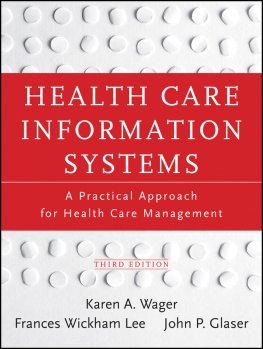Systems of Health Care
Also in This Series
Assuring Quality Ambulatory Health Care: A Case Study, Donald Angehr Smith and Gitanjali Mukerjee
Westview Special Studies in Health Care
Systems of Health Care
Douglas R. Mackintosh
This comprehensive introductory text describes health systems in the United States and in other countries, with emphasis on their ability to deliver goods and services, their cost, and their operation within a legal framework. Included is a discussion of such major developments as prepaid group practice, automated multiphasic health testing, national health insurance, professional standards review organizations, comprehensive health planning, and malpractice arbitration. The author underlines the salient features of the various systems by presenting and discussing advertisements for health products and services. Flow diagrams, charts, tables, and discussion questions help the reader understand the complexities and interrelationships of health care systems. Extensive references and suggestions for further reading are also included.
Douglas R. Mackintosh works in the health systems division of Analytic Services, a Washington-based consulting firm. He previously taught in the Department of Management and Marketing at the University of New Orleans. While in New Orleans, he worked at a multiphasic health-testing facility, participated in a pediatric arteriosclerosis research project, and helped establish an outpatient abortion clinic. Dr. Mackintosh holds degrees in chemistry, business administration, hygiene, and public health. His publications include The Economics of Airborne Emissions.
Systems of Health Care
Douglas R. Mackintosh
First published 1978 by Westview Press
Published 2019 by Routledge
52 Vanderbilt Avenue, New York, NY 10017
2 Park Square, Milton Park, Abingdon, Oxon OX14 4RN
Routledge is an imprint of the Taylor & Francis Group, an informa business
Copyright 1978 by Taylor & Francis
All rights reserved. No part of this book may be reprinted or reproduced or utilised in any form or by any electronic, mechanical, or other means, now known or hereafter invented, including photocopying and recording, or in any information storage or retrieval system, without permission in writing from the publishers.
Notice:
Product or corporate names may be trademarks or registered trademarks, and are used only for identification and explanation without intent to infringe.
Library of Congress Cataloging in Publication Data
Mackintosh, Douglas R.
Systems of health care.
(Westview special studies in health care)
Bibliography: p.
1. Medical careUnited States. 2. Medical care. I. Title. II. Series. [DNLM: 1. Delivery of health
careStandardsUnited States. 2. Quality of health careUnited States. 3. Evaluation studies.
W84 AA1 M156s]
Ra395.A3M28 362.1'0973 78-3134
ISBN 13: 978-0-367-28939-3(hbk)
To Dr. Cicely Williams,
a beautiful, genuine person
In this life we must consider ourselves lucky indeed if we have the good fortune to be befriended by one or two great individuals. Dr. Williams was the first to identify kwashiorkor, the "weaning disease," which she came in contact with while serving as a pediatrician in the British Colonial Service in Ghana in 1931. Her rich and remarkable life is reflected in the warmth and enthusiasm she shares with her students and friends even as she approaches her eighty-third year. I consider myself extremely lucky to have been exposed to her wisdom and her values.
For a closer look at Dr. Williams' life and work, see Ann Daily's Cicely: The Story of a Doctor (London: Victor Gollancz Ltd., 1968now out of print); and Mother and Child Health: Delivering the Services (New York: Oxford University Press, 1972), by Cicely D, Williams and Derrick B. Jelliffe.
Man ain't really evil, he jest ain't got any sense.
William Faulkner
It is difficult to review and evaluate the U.S. health care delivery system because it is not a comprehensive, formal, rational structure, such as exists in Great Britain or the Soviet Union, with the exception of a few subcomponents such as the military medical system or the Indian Health Service. The U.S. health care system has been criticized by consumers, planners, politicians, lawyers, and, of course, by the health providers themselves. No one is satisfied, it would seem, and as a result, the same evolutionary forces of change, in a fragmented and disorganized fashion, are occurring as they have since health services first developed in the Americas. The major issue today, as it has been for several decades, is whether a revolutionary change should occur in this "nonsystem," a change leading to a comprehensive, rational, centrally controlled, planned national health service, or whether change should be a gradual process representing a dynamic balance among the various political, technological, social, and economic processes in the United States.
The criticisms of the U.S. health care delivery system are many. They include: (1) maldistribution of resources, (2) the exclusion of large components of our society from adequate health services, (3) excessive cost, (4) excessive concentration of resources on technologically advanced curative services rather than on preventive services, (5) unfavorable national health statistics, (6) excessive allocation of resources to irrelevant basic science research, (7) the existence of powerful interest groups that block innovation and change, (8) excessive profits by suppliers and providers, and (9) unreasonable expectations by consumers. The reader should consider these problems and others as he or she attempts to understand the factors behind these criticisms, explores their validity, formulates solutions, and finally assesses whether the changes that would be proposed would really improve the situation.
A major aspect of these problems is that good health and the factors that contribute toward it bear little relationship to medical care. The World Health Organization defines health as "a state of complete physical, mental, and social well-being and not merely the absence of disease or infirmity." The U.S. health care delivery systemreferred to here occasionally as medical carereally provides medical, dental, pharmacological, social, nursing, and custodian services, among others. Of course, medical care contributes to the good health of individuals in a few circumscribed areas such as preventive health care services to mothers and children and in the care of certain acute major medical and surgical problems such as appendicitis and infectious diseases. For the most part, however, medical services merely supervise the inevitable and, at best, make people feel comfortable because they have been exposed to shiny modern technology in amenable surroundings. Many a wise physician has observed that 85 percent of patients get well and 10 percent die regardless of what one does, so that the primary service provided is supportive. The old dictum primum non nocere ("first of all do no harm") is quite relevant here. Only in about 5 percent of encounters will medical skills really make any difference. For this reason, many unorthodox providers, such as chiropractors, faith healers, and the like are quite successful.











